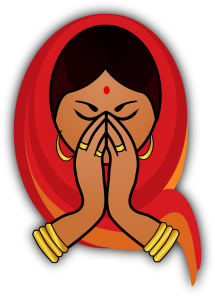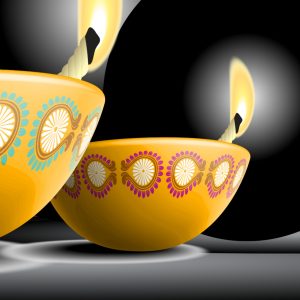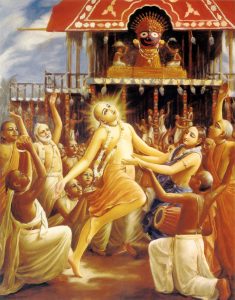

The following are excerpts from Walking with A Saint – Morning Walks and Conversations 2007/2008/2009 and 2010 by Śrīla Bhaktivedānta Nārāyaṇa Mahārāja
Walking with A Saint – Morning Walks and Conversations June 14, 2008 Morning Walk
Mahī-bharata dāsa: Śrīla Gurudeva, it says in Navadvīpa-dhāma Māhātmya that before Mahāprabhu’s 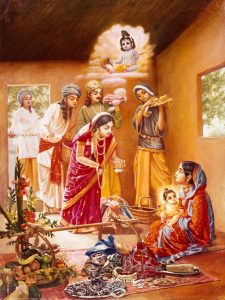 appearance five-hundred years ago, He manifested His form to many devotees, like Śrī Rāmānuja and Śrī Viṣṇusvāmī. At those times, did He appear as a sannyāsī or as He was in Navadvīpa?
appearance five-hundred years ago, He manifested His form to many devotees, like Śrī Rāmānuja and Śrī Viṣṇusvāmī. At those times, did He appear as a sannyāsī or as He was in Navadvīpa?
Śrīla Bhaktivedānta Nārāyaṇa Mahārāja: He appeared in His Navadvīpa-form. This is His eternal form, just as Śrī Kṛṣṇa’s eternal form is His human-like cowherd form of Śrī Vrajendra-nandana, the son of Nanda Mahārāja in Vṛndāvana. In that form Kṛṣṇa plays a flute and carries a stick. In this eternal form, and in His other forms, He comes to this world and manifests various sweet pastimes.
Śrī Caitanya Mahāprabhu’s form in Navadvīpa is eternal; it is eternally situated in Goloka Śvetadvīpa. His sannyāsa form is His naimittika-līlā (meaning that those pastimes take place only in this world; they do not take place in the spiritual world). Various personalities, like Śrī Rāmānuja, Brahmā, Indra, Mārkaṇḍeya Ṛṣi, the surabhī cow in Godruma, and Suvarṇa Sena Mahārāja saw that very Caitanya Mahāprabhu of Navadvīpa performing Hare Kṛṣṇa kīrtana.
Walking with A Saint – Morning Walks and Conversations June 23, 2007 Morning Walk
Śrīla Bhaktivedānta Nārāyaṇa Mahārāja: Ask about what you want to hear.
Śrīpāda Dāmodara Mahārāja: Śrīla Gurudeva, in other Kali-yugas, when Śrī Caitanya Mahāprabhu does not come, do the yuga-avatāras (the incarnations for the various Kali-yugas) also come in a golden complexion? Who are they?
Śrīla Bhaktivedānta Nārāyaṇa Mahārāja: Kalki comes, and if needed, other incarnations come.
Śrīpāda Dāmodara Mahārāja: But Kalki does not teach nāma-saṅkīrtana.
Śrīla Bhaktivedānta Nārāyaṇa Mahārāja: Never. He only kills demons.
Śrīpāda Dāmodara Mahārāja: Who teaches the yuga-dharma (the religious practice prescribed for a particular age) in other Kali-yugas?
Śrīla Bhaktivedānta Nārāyaṇa Mahārāja: When Śrī Caitanya Mahāprabhu does not come, Viṣṇu teaches it.
Vṛndāvana dāsa: Do those who are killed by Kalki get liberation?
Śrīla Bhaktivedānta Nārāyaṇa Mahārāja: Certainly. This is because Kalki is viṣṇu-tattva (a manifestation of Viṣṇu, or Kṛṣṇa Himself), not śaktyāveśa (a living entity empowered by the Lord for a specific mission).
Walking with A Saint – Morning Walks and Conversations June 29, 2008 Darśana
Gītā dāsī: In yuga cycles other than the present one, who comes in Dvāpara-yuga? Is it Vāsudeva Kṛṣṇa or a Viṣṇu incarnation?
Śrīla Bhaktivedānta Nārāyaṇa Mahārāja: Śrī Kṛṣṇa only comes once in one day of Brahmā. This is also true for Śrī Caitanya Mahāprabhu and Śrī Rāmacandra. In other Dvāpara-yugas, it is the manifestations of Kāraṇodakaśāyī Viṣṇu or Garbhodakaśāyī Viṣṇu who come, and they establish yuga-dharma (the religious process for the age). For example, the yuga-dharma of Dvāpara-yuga is arcana (temple worship), and the yuga-dharma of Kali-yuga is harināma-saṅkīrtana.
Walking with A Saint – Morning Walks and Conversations May 13, 2008 Morning Walk
Devotee: Right now we are living in Kali-yuga, the degraded age of quarrel and hypocrisy, so why is there a 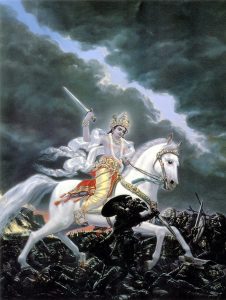 rumour in the world that human civilization is escalating to new heights of consciousness? For example, there are more vegetarians than ever before and human rights have improved. Śrīmad-Bhāgavatam states that at the end of Kali-yuga men will be very small, but we see that our kids are bigger than us. Why is this so? How do we reconcile this?
rumour in the world that human civilization is escalating to new heights of consciousness? For example, there are more vegetarians than ever before and human rights have improved. Śrīmad-Bhāgavatam states that at the end of Kali-yuga men will be very small, but we see that our kids are bigger than us. Why is this so? How do we reconcile this?
Śrīla Bhaktivedānta Nārāyaṇa Mahārāja: All Kali-yugas except for this particular Kali-yuga are full of innumerable sinful activities. Although this Kali-yuga is also full of sinful activities, they are less in comparison to previous Kali-yugas.
In this Kali-yuga Śrī Caitanya Mahāprabhu, who is Śrī Kṛṣṇa Himself, came and preached “Hare Kṛṣṇa, Hare Kṛṣṇa.” He taught us that all beings are spirit souls and that they must have love and affection for Kṛṣṇa. We are also preaching this message in every country, and that is why this Kali-yuga is special.
Śrīpāda Mādhava Mahārāja: This Kali-yuga is called dhanya-kali, meaning ‘blessed Kali-yuga.’
Śrīla Bhaktivedānta Nārāyaṇa Mahārāja: At the end of the other Kali-yugas, the Kalki incarnation descends and cuts off the heads of the demons, ushering in Satya-yuga again. In this Kali-yuga, Kalki will not appear.
Walking with A Saint – Morning Walks and Conversations May 18, 2008 Morning Walk
Vrajanātha dāsa: Śrīman Mahāprabhu came here when Śrī Kṛṣṇa contemplated, “How much does Śrīmatī Rādhikā love Me? How great is Her love? How great is Her happiness? And what qualities in Me does She relish?” Is this also happening in Goloka Vṛndāvana, or only when Kṛṣṇa’s pastimes manifest in this world?
Śrīla Bhaktivedānta Nārāyaṇa Mahārāja: After Śrī Kṛṣṇa’s pastimes in this world were completed – in Vṛndāvana, Mathurā, and everywhere else – He disappeared and went to Goloka Vṛndāvana. It is there in Goloka Vṛndāvana that He experienced these three desires.
Walking with A Saint – Morning Walks and Conversations May 1, 2008 Morning Walk
Raghunātha Bhaṭṭa dāsa: I have a question, Gurudeva. Why were these three internal desires considered to be a reason for Kṛṣṇa to come to this material world? Why could He not simply fulfil them in the spiritual world?
Śrīla Bhaktivedānta Nārāyaṇa Mahārāja: I gave the answer to this question yesterday, but you were not here.
(To Śrīpāda Āśrama Mahārāja) What did I say yesterday?
Śrīpāda Āśrama Mahārāja: You said that Śrī Kṛṣṇa is parama-karuṇa, most merciful. He comes here so that those within this material world would be able to understand this very deep, confidential topic.
Śrīla Bhaktivedānta Nārāyaṇa Mahārāja: If Śrī Kṛṣṇa had tasted this only in Goloka, we would never have known about it. He descended with all of His associates to give us knowledge of all these truths.
Walking with A Saint – Morning Walks and Conversations April 30, 2008 Morning Walk
Aniruddha dāsa: Śrī Caitanya Mahāprabhu is Kṛṣṇa Himself. Kṛṣṇa came as Mahāprabhu to experience Śrīmatī Rādhārāṇī’s feelings. In order to experience the feelings of a woman, why did He not come as a woman?
Śrīla Bhaktivedānta Nārāyaṇa Mahārāja: Kṛṣṇa did not desire to come in the form of a lady. He was thinking, “I should be a sannyāsī, and therefore all of My associates, such as Rādhārāṇī, Viśākhā, and Lalitā, should come as males.”
Walking with A Saint – Morning Walks and Conversations May 28, 2009 Morning Walk
Mukunda dāsa: As part of Lord Caitanya’s pastimes, He brought the yuga-dharma (the religious practice prescribed for that particular millennium) for everyone in the world. We also understand from you that most people who come to His line are in mādhurya-rasa, and sometimes in sakhya-rasa. So it appears there is some conflict, or difference, in these two statements.
Śrīla Bhaktivedānta Nārāyaṇa Mahārāja: When Caitanya Mahāprabhu came here from Goloka Vaikuṇṭha, the associates of Rāma, Nṛsiṁha, and all other incarnations descended with Him (within His body). Therefore, although most of His devotees were in mādhurya-rasa, some were in other rasas. A few examples of this are Murari Gupta, Anupama, and Nṛsiṁhānanda Brahmacārī; and there were so many more. However, those who actually followed the instruction of Caitanya Mahāprabhu regarding the gift He specifically came to give were all in mādhurya-rasa.
Devotee: But we have also heard that Mahāprabhu came for the whole world. How can both principles be true?
Śrīla Bhaktivedānta Nārāyaṇa Mahārāja: Yes, both statements are true. Vātsalya (parental love), sakhya (friendship), and dāsya (servitorship) are all included in mādhurya-rasa (amorous love). For example, those who are attracted to dāsya-rasa, due to having dāsya as their constitutional form, attain dāsya.
It is not that all rasas are equal. One can withdraw from the bank as much as one has in his account, and there are so many thousands of devotees who have a great deal in their account.
Walking with A Saint – Morning Walks and Conversations March 20, 2010 Morning Walk
Śrīpāda Padmanābha Mahārāja: Śrīman Mahāprabhu is the personification of the moods of separation (vipralambha-bhāva). Even in prakaṭa Navadvīpa-dhāma, in His kīrtanas He experiences these moods in places like Śrīvāsa-aṅgana. He is experiencing all of Śrīmatī Rādhikā’s moods there. Is this correct?
Śrīla Bhaktivedānta Nārāyaṇa Mahārāja: Yes. Not vividly, but in a covered way. For example, a student of Navadvīpa challenged Mahāprabhu: “Why are You chanting the names ‘Gopī! Gopī!’ instead of the holy name of Kṛṣṇa?”
At that time Mahāprabhu was totally absorbed in the moods of the gopīs and Śrīmatī Rādhikā. He was especially absorbed in the moods of the gopīs, and He had been thinking that Kṛṣṇa was giving suffering to Śrīmatī Rādhikā.
Walking with A Saint – Morning Walks and Conversations March 20, 2010 Morning Walk
Śrīpāda Nemi Mahārāja: Śrī Caitanya Mahāprabhu is Kṛṣṇa with the mood of Rādhārāṇī – śrī kṛṣṇa caitanya rādhā-kṛṣṇa nahe anya. So, does this mean that Rādhārāṇī is fully present in Mahāprabhu?
Śrīla Bhaktivedānta Nārāyaṇa Mahārāja: Yes, in Mahāprabhu.
Walking with A Saint – Morning Walks and Conversations May 3, 2008 Morning Walk
Vrajendra-nandana dāsa: If Śrī Caitanya Mahāprabhu was in the mood of Śrīmatī Rādhikā, why was He chanting, “Gopī, gopī,” after returning from Gaya?
Śrīla Bhaktivedānta Nārāyaṇa Mahārāja: He was not always in the mood of Śrīmatī Rādhikā. When He was in internal consciousness, He was sometimes in the mood of a sakhī or mañjarī. He was especially in the mood of Śrīmatī Rādhikā, but sometimes He was in the mood of a sakhī. He would sometimes become angry, because the sakhīs cannot tolerate when Kṛṣṇa cheats Śrīmatī Rādhikā and makes Her ‘suffer.’ It is for this reason that He would sometimes chant “Gopī, gopī” rather than Kṛṣṇa’s name.
Prema-prayojana dāsa: Should we consider that Mahāprabhu was in a sakhī-mood at the time that student said, “Chant Kṛṣṇa,” and Mahāprabhu took a stick to beat him?
Śrīla Bhaktivedānta Nārāyaṇa Mahārāja: Yes, that is right. Sometimes He feels like a mañjarī or sakhī, but that is rare.
Vrajendra-nandana dāsa: You said that Mahāprabhu was teaching us that in order to make progress in bhajana, we must give up our dearest object of love, just as He gave up the association of Viṣṇupriyā-devī. My question is this: If He was so attached to Viṣṇupriyā, why did He not show her very much affection until their last night together?
Śrīla Bhaktivedānta Nārāyaṇa Mahārāja: He did not have the same kind of love and affection as Kṛṣṇa, because He was in Rādhikā’s mood. When Kṛṣṇa was in the form of Śacīnandana Gaurahari, at that time His queen, Satyabhāmā, was in the form of Viṣṇupriyā-devī. In Dvārakā, Satyabhāmā was most beloved to Kṛṣṇa because she greatly resembled Rādhikā; that is why Kṛṣṇa married her. Rukmiṇī was His principal queen, but Satyabhāmā was dearer to Him than Rukmiṇī because, like Rādhikā, she had a leftist, or contrary, mood (vāmya-bhāva).
Walking with A Saint – Morning Walks and Conversations May 24, 2008 Morning Walk
Vrajanātha dāsa: Śrīla Gurudeva, Vṛndā has a question. Navadvīpa is like Vṛndāvana. It is gupta, or hidden, Vṛndāvana. All rasas, namely, dāsya (servitorship), sakhya (friendship), vātsalya (parenthood), and mādhurya (amorous love) are present in Vṛndāvana. Regarding Śrīman Mahāprabhu’s pastimes, all rasas must also be present. How is mādhurya-rasa present in Mahāprabhu’s līlā?
Śrīla Bhaktivedānta Nārāyaṇa Mahārāja: Mahāprabhu is the gupta-avatāra, the hidden incarnation. Everything is present within Him and His abode, but it is hidden. Vṛndāvana, Rādhā-kuṇḍa, Śyāmakuṇḍa, Girirāja Govardhana, Nandagrāma, Varṣāṇā, and all other pastime places are situated in Navadvīpa, but in a hidden way. Only those who take shelter of an elevated Vaiṣṇava and Śrī Kṛṣṇa can see this.
Vṛndā-devī dāsī: How did Mahāprabhu experience mādhurya-rasa if outwardly the sakhīs and mañjarīs are not present there?
Śrīla Bhaktivedānta Nārāyaṇa Mahārāja: He does so by mind. Everything is eternally present there, although it is not manifest externally.
Walking with A Saint – Morning Walks and Conversations June 13, 2010 Morning Walk
Devotee: In Navadvīpa-dhama, Govardhana is in Koladvīpa. Rādhākuṇḍa and Śyāma-kuṇḍa are in Ṛtudvīpa. What is the speciality of them being in different places? In Vṛndāvana, they are very near each other.
Śrīla Bhaktivedānta Nārāyaṇa Mahārāja: It has been written by Śrīla Bhaktivinoda Ṭhākura that this is the wish of Kṛṣṇa. In Navadvīpa there is some difference. The pastime places are somewhat here and there [not in the same order as they are seen in Vṛndāvana]. But why? By the wish of Gauracandra.
Vidura dāsa: When we meditate on Mahāprabhu, do we only think of Him before He was a sannyāsī?
Śrīla Bhaktivedānta Nārāyaṇa Mahārāja: In boyhood, when He was in Navadvīpa. This is better.
Devotee: It says that Mādhavendra Purī is the first sprout of mādhurya-rasa in the line of Madhvācārya. Did he get this sprout from his guru? Or from Kṛṣṇa?
Śrīla Bhaktivedānta Nārāyaṇa Mahārāja: A seed came into his heart.
Especially it is told that he is personally the first sprout. Padmanābha Mahārāja will answer further.
Śrīpāda Padmanābha Mahārāja: My understanding is that it is by the will of Śrī Caitanya Mahāprabhu. In the same way, Caṇḍīdāsa and Vidyāpati came before the time of Mahāprabhu, by His will, so that He would have the opportunity to hear their expressions of separation.
Walking with A Saint – Morning Walks and Conversations July 9, 2010 Morning Walk
Śrīpāda Tridaṇḍi Mahārāja: Gurudeva, Śrī Caitanya Mahāprabhu explained parakīya-bhāva. But Śukadeva Gosvāmī and Jayadeva Gosvāmī explained this before Him. So, what is the speciality of Mahāprabhu’s explanation?
Śrīla Bhaktivedānta Nārāyaṇa Mahārāja: Śrīman Mahāprabhu told Rūpa Gosvāmī, “I am telling you in brief. You should elaborate on My words, and write books to clarify this.” Rūpa Gosvāmī has done this.
Śrīpāda Mādhava Mahārāja: Neither Śukadeva Gosvāmī nor Jayadeva Gosvāmī nor Vidyāpati gave the process to achieve that parakīya-bhāva. Rūpa Gosvāmī explained it by the mercy of Śrīman Mahāprabhu, and he taught how to achieve it.
Śrīla Bhaktivedānta Nārāyaṇa Mahārāja: Jīva Gosvāmī learned from Rūpa Gosvāmī and others that parakīya-bhāva had been revealed before Caitanya Mahāprabhu. But it was by the teachings of Rūpa Gosvāmī that Caitanya Mahāprabhu elaborated on its understanding and gave the process for its attainment.
Walking with A Saint – Morning Walks and Conversations April 29, 2008 Darśana
Sugata dāsa: We are instructed by our guru to serve the Vaiṣṇavas. Our parents and children are Vaiṣṇavas, but still, parents are elderly and children are growing up. We must maintain them, and this keeps us from chanting fulltime. How do we reconcile this?
Śrīla Bhaktivedānta Nārāyaṇa Mahārāja: Let us take the example of Śrī Caitanya Mahāprabhu. What did He do? His mother was old. Did she believe in God, or not?
Sugata dāsa: She was a Vaiṣṇavī.
Śrīla Bhaktivedānta Nārāyaṇa Mahārāja: She was not just a Vaiṣṇavī; she was a parama (topmost) Vaiṣṇavī. She came from Goloka Vṛndāvana; She is Mother Yaśodā herself, and Kauśalyā (the mother of Lord Śrī Rāmacandra) is her manifestation. As far as Mahāprabhu’s wife, Viṣṇupriyā-devī, is concerned, she was not at all against bhakti. Rather, she is the embodiment of bhakti.
So why did Mahāprabhu leave His mother and wife? Why did He go to Kaṭvā to take sannyāsa? It was not for Himself. He did it to teach all jīvas, “Your first duty is to serve Kṛṣṇa.” And, even more prominent than Kṛṣṇa’s service is Rādhā’s service. This is what Mahāprabhu’s associate, Śrīla Rūpa Gosvāmī, came to tell you.
Walking with A Saint – Morning Walks and Conversations January 5, 2009 Śloka Class
Tamopahā dāsa: If one is interested in crossing the ocean of saṁsāra (material existence), if one is interested in hearing the nectar of saṅkīrtana, if one wants to taste the ocean of love, then one must take shelter of Śrī Caitanya Mahāprabhu.
Śrīla Bhaktivedānta Nārāyaṇa Mahārāja: Why don’t you say, “One must be surrendered to Kṛṣṇa?”
Tamopahā dāsa: Because Mahāprabhu is more merciful than Kṛṣṇa.
Śrīla Bhaktivedānta Nārāyaṇa Mahārāja: Yes. Kṛṣṇa has no time. He is always engaged in rasa with His mother, and He is busy cow herding with His friends. He has come in the form of Mahāprabhu only to hear our prayers and to deliver us. Caitanya Mahāprabhu is most merciful. He travelled throughout India to help devotees and non-devotees alike. He made so many Vaiṣṇavas – hundreds of thousands.
Kṛṣṇa didn’t travel in that way. Rather, He went to fight in the Mahābhārata War, and also to fight with Śālva, Jarāsandha, and other demons. He traveled to fight, whereas Mahāprabhu didn’t go anywhere to fight.
Walking with A Saint – Morning Walks and Conversations May 26, 2008 Darśana
Devotee: One last question, Śrīla Gurudeva. Why did Śrī Caitanya Mahāprabhu take sannyāsa? Was it just to gain respect, or did He want to teach us something?
Śrīla Bhaktivedānta Nārāyaṇa Mahārāja: He took sannyāsa in order to perform sweet, heart-wrenching pastimes, so that by hearing about them at present or in the future one will at once become a devotee. Everyone will follow the Lord’s instructions and character, thinking, “We should be ideal like Śrī Caitanya Mahāprabhu. We should give up material enjoyment and perform bhajana.”
Walking with A Saint – Morning Walks and Conversations July 5, 2010 Darśana
Śrīpāda Śuddhādvaitī Mahārāja: I have a question regarding the jīva who is going from taṭasthā to Vaikuṇṭha. Does he have to do any particular sādhana to be admitted?
Śrīpāda Mādhava Mahārāja: His looking towards Vaikuṇṭha alone is his sādhana.
Śrīpāda Śuddhādvaitī Mahārāja: Can he go even to Kṛṣṇaloka, to Goloka?
Śrīla Bhaktivedānta Nārāyaṇa Mahārāja: To go to Goloka is not easy. Most go up to Nārāyaṇa-loka (Vaikuṇṭha). Śrī Caitanya Mahāprabhu came and disclosed all these truths about Goloka Vṛndāvana [through His followers]. Before that, no one knew them.
Devotee: Śrīla Kṛṣṇadāsa Kavirāja Gosvāmī has said in Caitanya-caritāmṛta that when Mahāprabhu was present in this world, all the jīvas were liberated.
Śrīla Bhaktivedānta Nārāyaṇa Mahārāja: Those whom Śrī Caitanya Mahāprabhu saw, and whom His devotees saw – only they were liberated. The words ‘whole world’ does not include those places where Caitanya Mahāprabhu and His associates have not gone. But now, Śrīla Bhaktivedānta Svāmī Mahārāja has come and I have come. By our contact, so many will be liberated.
Walking with A Saint – Morning Walks and Conversations April 29, 2008 Morning Walk
Śrīpāda Āśrama Mahārāja: Śrīla Gurudeva, in Śrī Caitanya-caritāmṛta there is this verse:
prema-rasa-niryāsa karite āsvādana
rāga-mārga bhakti loke karite pracāraṇa
rasika-śekhara kṛṣṇa parama-karuṇa
ei dui hetu haite icchāra udgama
(Śrī Caitanya-caritāmṛta, Ādi-līlā 4.15–16)
The Lord’s desire to appear was born from two reasons: The Lord wanted to taste the sweet essence of the mellows of love of God, and He wanted to propagate devotional service in the world on the platform of spontaneous attraction. Thus He is known as supremely jubilant and as the most merciful of all.
It is in Goloka that Kṛṣṇa tries to understand Śrīmatī Rādhārāṇī’s love. Why does He need to come here and perform pastimes in order to understand it, when He can do so in Goloka?
Śrīla Bhaktivedānta Nārāyaṇa Mahārāja: Kṛṣṇa is very merciful. He did not want this rasa to be limited to Goloka Vṛndāvana. He thought, “Why not give it to the entire world? It should be to everyone’s benefit.” He therefore gave rāga-mārga, the path of spontaneous love for Kṛṣṇa, so that the people of this world would be able to attain that highest stage of devotion. This is why.
If He tastes Her love only in Goloka Vṛndāvana, how would we be able to attain rāgānuga-bhakti and ultimately rūpātmika-bhakti? He came and gave this secret thing. Especially, Advaita Ācārya (who is a manifestation of Sadāśiva Viṣṇu) had prayed to Kṛṣṇa, “Come at once. If You do not come, I will destroy the entire universe. You must come. Only You can give that prema. I can give yuga-dharma, the religious practice for the age, and I can preach the glories of the mahā-mantra, but I cannot give the highest kṛṣṇa-prema – gopī-prema. You will have to give that.”
Prāṇa-govinda dāsa: Śrīla Gurudeva, if someone does not come in contact with a sādhu, he may read about the Lord’s activities and then commit offenses by thinking that these activities – cows licking His body and His bones separating at the joints – are not God’s activities. What is that person’s situation?
Śrīla Bhaktivedānta Nārāyaṇa Mahārāja: Śrī Caitanya Mahāprabhu’s associates like Śrīla Rāya Rāmānanda,  Śrīla Svarūpa Dāmodara, and Śrīla Rūpa Gosvāmī descended from Goloka Vṛndāvana to explain the moods of Śrī Caitanya Mahāprabhu. This is why they came. Just as Kṛṣṇa does not come to this world alone, Mahāprabhu also does not come alone.
Śrīla Svarūpa Dāmodara, and Śrīla Rūpa Gosvāmī descended from Goloka Vṛndāvana to explain the moods of Śrī Caitanya Mahāprabhu. This is why they came. Just as Kṛṣṇa does not come to this world alone, Mahāprabhu also does not come alone.
Śrīpāda Padmanābha Mahārāja: Śrīla Gurudeva, many years ago, when we were in Fiji on Śrī Advaita Ācārya’s appearance day, you were asking each of us to speak about the pañca-tattva. You asked, “Can Advaita Ācārya give vraja-prema? Can Gadādhara Paṇḍita or Nityānanda Prabhu give it? You then explained that all of them can give prema because they are all there in Goloka Vraja; Nityānanda Prabhu is there as Anaṅga Mañjarī and Balarāma, and Advaita Ācārya is there as Gopīśvara Mahādeva and Sadāśiva.
Śrīla Bhaktivedānta Nārāyaṇa Mahārāja: Only Gadādhara Paṇḍita can give prema as Śrī Caitanya Mahāprabhu gave it. While the others can also give it, Mahāprabhu and Gadādhara Paṇḍita give it better.
Sugata dāsa: Why is that so?
Śrīla Bhaktivedānta Nārāyaṇa Mahārāja: Śrī Kṛṣṇa is viṣaya-vigraha (the object of bhakti) and Gadādhara is āśraya-vigraha (the reservoir, or container, of bhakti). Gadādhara, who is Rādhikā Herself, can therefore give it better than Śrī Caitanya Mahāprabhu. With Gadādhara Paṇḍita’s help, Mahāprabhu is able to give it better than the others, because He is Kṛṣṇa who is now realizing the love of Śrīmatī Rādhikā. He has taken Her beauty and intrinsic mood.
Sugata dāsa: But first we approach guru and Nityānanda Prabhu?
Śrīla Bhaktivedānta Nārāyaṇa Mahārāja: Yes, that is right.
A madhyama-adhikārī guru knows everything about our conditioning in this world and our suffering due to being absorbed in worldly conceptions. His mercy comes first, then the mercy of Śrī Nityānanda Prabhu and the uttama-adhikārīs’ mercy, and then Śrīman Mahāprabhu’s and Śrī Kṛṣṇa’s mercy.
Śrīpāda Āśrama Mahārāja: Kṛṣṇa is rasika-śekhara, the topmost relisher, and He is raso vai saḥ, the embodiment of rasa. I have heard it said that Rādhārāṇī does not have rasa, but She is Mahābhāva Ṭhākurāṇī. She has bhāva, but Kṛṣṇa does not have bhāva. I am wondering; is this idea okay?
Śrīla Bhaktivedānta Nārāyaṇa Mahārāja: It is correct to say that Kṛṣṇa is the embodiment of rasa; but rasa cannot taste itself. It cannot know how tasteful it is. Rather, one who is drinking that rasa can taste it. Śrīmatī Rādhikā is drinking that nectar.
Śrīpāda Mādhava Mahārāja: Śyāma-rasa.
Śrīla Bhaktivedānta Nārāyaṇa Mahārāja: Therefore She knows the extent of the beauty, taste, and qualities of that rasa. Śrī Kṛṣṇa, who is Rasa Himself, cannot fully taste, tell, or explain about Himself.
Abhirāma dāsa: You said that one must first take shelter of a madhyama-adhikārī guru. If an uttama-adhikārī guru has not come down to the stage of madhyama to preach, can he still give shelter?
Śrīla Bhaktivedānta Nārāyaṇa Mahārāja: Uttama-adhikārīs do not have disciples, because they consider that everyone is already serving Kṛṣṇa and is therefore already liberated. They do not preach or give initiation. Śukadeva Gosvāmī is an example.
Śrīpāda Mādhava Mahārāja: And what about Nārada Ṛṣi?
Śrīla Bhaktivedānta Nārāyaṇa Mahārāja: Uttama-adhikārīs like Nārada Ṛṣi sometimes come to the platform of madhyama-adhikārī, and then they make disciples.
Śrīpāda Mādhava Mahārāja: In the same way, all the ācāryas in our guru-paramparā are uttama-adhikārīs who have come down to the madhyama platform to bestow mercy upon us. Don’t think that those in our guru-varga are madhyama-adhikārīs.
Walking with A Saint – Morning Walks and Conversations May 24, 2008 Morning Walk
Śrīpāda Padmanābha Mahārāja: Śrīla Gurudeva, the other day you said that Kṛṣṇa, in the form of Mahāprabhu, was fulfilling His three desires in a hidden way in Navadvīpa; and when He took sannyāsa and went to Purī with Rāmānanda Rāya and Svarūpa Dāmodara, He outwardly fulfilled these desires. So were His desires fulfilled, or not fulfilled, in Navadvīpa? Did He have to take sannyāsa to fulfil His desires?
Śrīla Bhaktivedānta Nārāyaṇa Mahārāja: Everything is already fulfilled in Mahāprabhu. He took sannyāsa for the benefit of the jīvas of the world. “Rāga-mārga bhakti loke karite pracāraṇa – He wanted to propagate devotional service in the world on the platform of spontaneous attraction.”
Śrīpāda Mādhava Mahārāja:
anugrahāya bhaktānāṁ
mānuṣaṁ deham āsthitaḥ
bhajate tādṛśīḥ krīḍā
yāḥ śrutvā tat-paro bhavet
(Śrīmad-Bhāgavatam 10.33.36)
When the Lord assumes a human-like body to show mercy to His devotees, He engages in such pastimes as will attract those who hear about them to become dedicated to Him.
Walking with A Saint – Morning Walks and Conversations May 17, 2009 Darśana
Śrīla Bhaktivedānta Nārāyaṇa Mahārāja: What is the reason behind Śrī Caitanya Mahāprabhu’s appearance in this world?
Kundalatā dāsī: śrī-rādhāyāḥ praṇaya … svādyo… Lost…
Śrīla Bhaktivedānta Nārāyaṇa Mahārāja: Why lost?
Kundalatā dāsī: I didn’t practice, so I forgot the verse.
Śrīla Bhaktivedānta Nārāyaṇa Mahārāja: Try again.
Kundalatā dāsī: śrī-rādhāyāḥ praṇaya-mahimā kīdṛśo vānayaivā…
Śrīla Bhaktivedānta Nārāyaṇa Mahārāja: Why are you looking towards your father?
Kundalatā dāsī: Because I forgot the verse.
Śrīla Bhaktivedānta Nārāyaṇa Mahārāja: If you don’t remember it, I will chastise you. (To Anupama dāsa) Do you remember?
Anupama dāsa: No.
Gopāla-kṛṣṇa dāsa: śrī-rādhāyāḥ praṇaya-mahimā kīdṛśo vānayaivā, svādyo yenādbhuta-madhurimā kīdṛśo vā madīyaḥ… saukhyaṁ cāsyā mad-anubhavataḥ
Śrīla Bhaktivedānta Nārāyaṇa Mahārāja: And what about the śloka beginning with anarpita-carīṁ?
Kundalatā dāsī:
anarpita-carīṁ cirāt karuṇayāvatīrṇaḥ kalau
samarpayitum unnatojjvala-rasāṁ sva-bhakti-śriyam
hariḥ puraṭa-sundara-dyuti-kadamba-sandīpitaḥ
sadā hṛdaya-kandare sphuratu vaḥ śacī-nandanaḥ
(Śrī Caitanya-caritāmṛta, Ādi-līlā 1.4)
[May the Supreme Lord who is known as the son of Śrīmatī Śacī-devī be transcendentally situated in the innermost chambers of your heart. Resplendent with the radiance of molten gold, He has appeared in the age of Kali by His causeless mercy to bestow what no incarnation has ever offered before: the most sublime and radiant mellow of devotional service, the mellow of conjugal love.]
Śrīla Bhaktivedānta Nārāyaṇa Mahārāja: It is so important that you remember this well. What is the meaning of anarpita-carīṁ cirāt karuṇayāvatīrṇaḥ kalau?
Kundalatā dāsī: May the son of Mother Śacī [Śrī Caitanya Mahāprabhu] be situated in the innermost recesses of your heart. He has appeared in this age of Kali to bestow what has not been given in a long time; the beauty of Śrīmatī Rādhikā’s love, which is mañjarī-bhāva.
Śrīla Bhaktivedānta Nārāyaṇa Mahārāja: Kṛṣṇa came to this world in the form of Caitanya Mahāprabhu, and the first reason for this is the following:
yadā yadā hi dharmasya
glānir bhavati bhārata
abhyutthānam adharmasya
tadātmānaṁ sṛjāmy aham
(Bhagavad-gītā 4.7)
[O descendant of Bharata, whenever there is a decline of religion and an increase in irreligion, at that time I manifest My eternally perfect form in this mundane world.]
paritrāṇāya sādhūnāṁ
vināśāya ca duṣkṛtām
dharma-saṁsthāpanārthāya
sambhavāmi yuge yuge
(Bhagavad-gītā 4.8)
[To protect My unalloyed devotees, to annihilate the wicked, and to firmly establish religion, I appear in every age.]
When adherence to religious principles decreases, the demons are able to create many problems and sanātana-dharma becomes hidden. Kṛṣṇa descends in order to kill the demons and save the sādhus. This is the meaning of dharma-saṁsthāpanārthāya.
The second reason for His descent is that, seeing the world overwhelmed in sin, Advaita Ācārya prayed to Him, “If You do not come and give the people kṛṣṇa-prema, I will destroy the entire universe.” In this way, Advaita Ācārya brought Him from Goloka Vṛndāvana.
The third reason is that Kṛṣṇa wanted to give the prema that had not been given since the previous day of Brahmā: unnatojjvala rasāṁ sva-bhakti-śriyam, or mañjarī-bhāva, personal service to Śrīmatī Rādhikā.
And the fourth reason is this:
śrī-rādhāyāḥ praṇaya-mahimā kīdṛśo vānayaivā-
svādyo yenādbhuta-madhurimā kīdṛśo vā madīyaḥ
saukhyaṁ cāsyā mad-anubhavataḥ kīdṛśaṁ veti lobhāt
tad-bhāvāḍhyaḥ samajani śacī-garbha-sindhau harīnduḥ
(Śrī Caitanya-caritāmṛta, Ādi-līlā 1.6)
[Desiring to understand the glory of Rādhārāṇī’s love, the wonderful qualities in Him that She alone relishes through Her love, and the happiness She feels when She realizes the sweetness of His love, the Supreme Lord Hari, richly endowed with Her emotions, appeared from the womb of Śrīmatī Śacī-devī, as the moon appeared from the ocean.]
What is the significance of rādhā-praṇaya, Śrīmatī Rādhikā’s love for Kṛṣṇa? Before praṇaya comes prema, sneha, and māna; then comes praṇaya. It is a most exalted stage of prema.
What is its nature? Rādhā is the only one who fully tastes Kṛṣṇa’s beauty, name, sweet pastimes, qualities, and love. She is the only one. In order to personally realize the happiness She feels in Their relationship, Kṛṣṇa took Her intrinsic mood and beauty, and appeared in the form of Śrī Caitanya Mahāprabhu.
If Mahāprabhu had not come to this world, how could we have known what is pure bhakti, what is love and affection, who is Kṛṣṇa, who is Rādhikā, and what is the significance of Vṛndāvana? We know this only by the mercy of Caitanya Mahāprabhu.
Mahāprabhu inspired Śrīla Rūpa Gosvāmī, and through Rūpa Gosvāmī He preached the glory of the gopīs’ upapati-bhāva (paramour love). This mood of the gopīs is special; it is not found in any other sampradāya in the world. If one realizes this mood, that person will factually know the identity of Caitanya Mahāprabhu.
Walking with A Saint – Morning Walks and Conversations May 17, 2009 Darśana
Gopāla-kṛṣṇa dāsa: You first discussed the reasons for Caitanya Mahāprabhu’s appearance. In Śrī Caitanya-caritāmṛta (Ādi-līlā 4.15) it is stated:
prema-rasa-niryāsa karite āsvādana
rāga-mārga bhakti loke karite pracāraṇa
[The Lord’s desire to appear was born from two reasons: the Lord wanted to taste the sweet essence of the mellows of love of God, and He wanted to propagate devotional service in the world on the platform of spontaneous attraction.]
But later in the fourth chapter it is stated:
ei mata caitanya-kṛṣṇa pūrṇa bhagavān
yuga-dharma-pravartana nahe tāṅra kāma
(Śrī Caitanya-caritāmṛta, Ādi-līlā 4.37)
For Śrī Kṛṣṇa Caitanya, the Supreme Personality of Godhead, promulgating the dharma of the age is incidental.
From this it seems that paritrāṇāya sādhūnāṁ (delivering the saintly devotees) and dharma-saṁsthāpanārthāya (establishing religious principles) are not the real reasons for the Lord’s descent.
Śrīla Bhaktivedānta Nārāyaṇa Mahārāja: In this connection, sādhunam refers to the gopīs. The gopīs are the real sādhus. The followers of Śrī Caitanya Mahāprabhu are thus the real sādhus because their only desire is to attain gopī-bhāva. This is the true meaning of sanātana-dharma: to protect and preach this mission of Caitanya Mahāprabhu. So, it is not wrong.
Walking with A Saint – Morning Walks and Conversations May 1, 2008 Morning Walk
Śrīla Bhaktivedānta Nārāyaṇa Mahārāja: With reference to this verse, what were Śrī Kṛṣṇa’s three desires?
śrī-rādhāyāḥ praṇaya-mahimā kīdṛśo vānayaivā-
svādyo yenādbhuta-madhurimā kīdṛśo vā madīyaḥ
saukhyaṁ cāsyā mad-anubhavataḥ kīdṛśaṁ veti lobhāt
tad-bhāvāḍhyaḥ samajani śacī-garbha-sindhau harīnduḥ
(Śrī Caitanya-caritāmṛta, Ādi-līlā 1.6)
Desiring to understand the glory of Rādhārāṇī’s love, the wonderful qualities in Him that She alone relishes through Her love, and the happiness She feels when She realizes the sweetness of His love, the Supreme Lord Hari, richly endowed with Her emotions, appeared from the womb of Śrīmatī Śacī-devī, as the moon appeared from the ocean.
Śrīpāda Bhāgavata Mahārāja: He wanted to understand the prema tasted by Śrīmatī Rādhārāṇī.
Śrīla Bhaktivedānta Nārāyaṇa Mahārāja: What prema?
Śrīpāda Bhāgavata Mahārāja: The greatness of the prema.
Śrīla Bhaktivedānta Nārāyaṇa Mahārāja: What prema?
Śrīpāda Bhāgavata Mahārāja: He wanted to understand His own rūpa-mādhurī, the sweetness of His form …
Śrīla Bhaktivedānta Nārāyaṇa Mahārāja: You have not presented this correctly.
Śrīpāda Bhāgavata Mahārāja: Śrīmatī Rādhārāṇī was seeing something in Him and He wanted to understand what She was seeing.
Śrīla Bhaktivedānta Nārāyaṇa Mahārāja: No, no, no. Your presentation is totally wrong. First properly explain the first desire, and then the second desire.
Śrīpāda Bhāgavata Mahārāja: First was the prema. Kṛṣṇa wanted to know the nature of the love She was experiencing.
Śrīla Bhaktivedānta Nārāyaṇa Mahārāja: It is true that prema means ‘love,’ but in this verse the word praṇaya is used, not prema. Is there something special in praṇaya that differentiates it from prema?
Śrīpāda Bhāgavata Mahārāja: There is a special thing in praṇaya.
Śrīla Bhaktivedānta Nārāyaṇa Mahārāja: What is it?
Śrīpāda Bhāgavata Mahārāja: There are stages of prema up to mādanākhya-mahābhāva, like rāga, anurāga, praṇaya, and so on.
Śrīla Bhaktivedānta Nārāyaṇa Mahārāja: Yes, not merely prema. Prema develops further to sneha and māna, and then to praṇaya. Praṇaya is Śrīmatī Rādhikā’s exalted mood. It is this mood that Kṛṣṇa wanted to experience.
Then, what was His second desire?
Śrīpāda Bhāgavata Mahārāja: Secondly, Kṛṣṇa thought, “Śrīmatī Rādhikā is seeing something in Me. She sees My rūpa-mādhurī (the sweetness of My extraordinarily beautiful form), veṇu-mādhurī (the sweet, mellow sound of My flute), and My līlā-mādhurī (the sweetness of My supremely captivating pastimes). What is She seeing in Me?”
Śrīla Bhaktivedānta Nārāyaṇa Mahārāja: You do not understand. Try to understand from those who know. Do not think that you know everything. This is not a topic that can be learned in one day. Try to hear again, and to know.
(To Śrīpāda Āśrama Mahārāja) Please explain this to him.
Śrīpāda Āśrama Mahārāja: śrī-rādhāyāḥ praṇaya-mahimā kīdṛśo vānayaivā. First, Kṛṣṇa wants to understand the mahimā, meaning the glory, of Śrīmatī Rādhikā’s praṇaya. For instance, He sees that in Her mood of separation from Him, She sometimes runs to a tamāla tree and embraces it, thinking it to be Him. Sometimes She chastises a rain-cloud, thinking it to be Him.
Kṛṣṇa was thinking, “What is the glory of Her love? I do not embrace the kadamba tree when I feel separation from Her. My love is not so high.” In this way He develops greed to understand the greatness of Śrīmatī Rādhārāṇī’s love.
Secondly, svādyo yenādbhuta-madhurimā kīdṛśo vā madīyaḥ. Śrī Kṛṣṇa is full with four mādhurīs, or four qualities of sweetness, the first of which is rūpa-mādhurī, the sweetness of His form. It is stated in Śrīmad-Bhāgavatam:
barhāpīḍaṁ naṭa-vara-vapuḥ karṇayoḥ karṇikāraṁ
bibhrad vāsaḥ kanaka-kapiśaṁ vaijayantīṁ ca mālām
randhrān veṇor adhara-sudhayāpūrayan gopa-vṛndair
vṛndāraṇyaṁ sva-pada-ramaṇaṁ prāviśad gīta-kīrtiḥ
(Śrīmad-Bhāgavatam 10.21.5)
Wearing a peacock-feather ornament upon His head, blue karṇikāra flowers on His ears, a yellow garment as brilliant as gold, and the vaijayantī garland, Lord Kṛṣṇa exhibited His transcendental form as the greatest of dancers as He entered the forest of Vṛndāvana, beautifying it with the marks of His footprints. He filled the holes of His flute with the nectar of His lips, and the cowherd boys sang His glories.
This sweet form is not possessed by any of His incarnations.
Only Kṛṣṇa has this rūpa-mādhurī. Then, veṇu-mādhurī:
iti veṇu-ravaṁ rājan
sarva-bhūta-manoharam
śrutvā vraja-striyah sarvā
varṇayantyo ‘bhirebhire
(Śrīmad-Bhāgavatam 10.21.6)
O King, the sound of Kṛṣṇa’s flute steals the minds of all living beings, both animate and inanimate. When the young gopīs of Vraja heard that sound, they began to describe it. As they went on describing the sound of the flute, they entered a state of ecstatic trance and became completely absorbed in thoughts of Śrī Kṛṣṇa. Within their hearts, they began to embrace Śrī Kṛṣṇa, who is the embodiment of all rasa and the reservoir of supreme spiritual bliss.
All living entities in Vṛndāvana become charmed and enchanted when they hear the song of Kṛṣṇa’s flute. Kṛṣṇa cannot understand this from the position of being the object of love (viṣaya). In order to understand, He must take the position of the abode of love (āśraya). Śrīla Gurudeva has explained…
Śrīla Bhaktivedānta Nārāyaṇa Mahārāja: This explanation is not exactly correct. Asvādyo yenādbhuta means ‘the wonderful sweetness that is relished by Śrīmatī Rādhikā.’ Only Śrīmatī Rādhikā can enjoy this. These four mādhurīs are kīdṛśaḥ. [Kīdṛśaḥ means ‘of what kind?’] Śrī Kṛṣṇa does not know how glorious His four mādhurīs are; only Śrīmatī Rādhikā knows.
What is Śrī Kṛṣṇa’s third desire?
Śrīpāda Āśrama Mahārāja: Saukhyaṁ cāsyā mad-anubhavataḥ kīdṛśaṁ veti lobhāt. Only Śrīmatī Rādhikā is able to taste the mādhurīs of Kṛṣṇa in a most super-excellent way; no one else can do so. Hṛdaya prema-darpaṇa – according to the love within one’s heart, one will be able to perceive the sweetness of the object of one’s love. Therefore, although Śrīmatī Rādhikā does not desire any happiness for Herself, when She tastes the sweetness of Śrī Kṛṣṇa, She feels a happiness which is unsurpassed. Seeing this, Śrī Kṛṣṇa becomes very greedy to experience Her happiness.
Śrīla Bhaktivedānta Nārāyaṇa Mahārāja: Śrīmatī Rādhikā enjoys the four mādhurīs of Kṛṣṇa and becomes so happy; and Kṛṣṇa wants to know what kind of happiness She is feeling.
(To Bhāgavata Mahārāja) You should know the details very clearly. It is not so easy to understand and express this with precision.
It is not like eating a rasagullā (an Indian sweet). Are there any questions?
Walking with A Saint – Morning Walks and Conversations May 24, 2008 Morning Walk
Śrīpāda Padmanābha Mahārāja: Going back to brahma-vimohana-līlā, this brings a question. You mentioned that there were four reasons why Kṛṣṇa performed this pastime. Of these, which is the main reason? Śrī Caitanya Mahāprabhu had external and internal reasons for appearing, so is there any order in the reasons regarding this pastime with Brahmā? The internal reason for Mahāprabhu’s appearance was to taste rasa. Can we say there is a main reason for Kṛṣṇa manifesting this pastime with Brahmā?
Śrīla Bhaktivedānta Nārāyaṇa Mahārāja: Mahāprabhu’s second reason was to give rāgānuga-mārga, the third was because of Advaita Ācārya’s prayer, and the fourth was this:
yadā yadā hi dharmasya
glānir bhavati bhārata
abhyutthānam adharmasya
tadātmānaṁ sṛjāmy aham
(Bhagavad-gītā 4.7)
O Bhārata, whenever there is a decline of dharma (religion) and an in crease in adharma (irreligion), at that time I manifest My eternally perfect form in this mundane world.
And there are so many other reasons.
Śrīpāda Padmanābha Mahārāja: Can we say that the main reason for brahma-vimohana-līlā was for Śrī Kṛṣṇa to taste the vātsalya-prema of all the cows and gopīs?
Śrīla Bhaktivedānta Nārāyaṇa Mahārāja: Kṛṣṇa externally performed this pastime to satisfy the desire of Lord Brahmā, and internally to fulfil the desires of the young gopīs, the mothers, and the cows.
This is very mysterious. What can you pay me for this? Only daṇḍavat-praṇāma?
Walking with A Saint – Morning Walks and Conversations September 22, 2008 Morning Walk
Śrīpāda Giri Mahārāja: Śrīla Gurudeva, there are two internal reasons and two external reasons for Śrīman 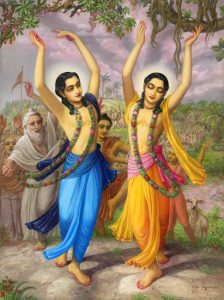 Mahāprabhu’s appearance. What are they?
Mahāprabhu’s appearance. What are they?
Śrīla Bhaktivedānta Nārāyaṇa Mahārāja: There are two prominent and two secondary reasons. What are the two secondary reasons?
Śrīpāda Giri Mahārāja: One of the secondary reasons was to distribute rāga-mārga, the path of rāgānugā-bhakti. The other was to establish the yuga-dharma, the religious process for the age, which is the chanting of the holy name.
Śrīla Bhaktivedānta Nārāyaṇa Mahārāja: And what are the internal reasons?
Śrīpāda Giri Mahārāja: The primary internal reason was to fulfil Kṛṣṇa’s desires to taste the three moods of Śrīmatī Rādhikā, and the secondary internal reason was to answer the prayers of Advaita Ācārya.
Walking with A Saint – Morning Walks and Conversations May 18, 2008 Morning Walk
Rasika-prīya dāsī: Śrī Caitanya Mahāprabhu is Kṛṣṇa feeling the separation moods of Śrīmatī Rādhikā in this world only, because in Goloka Vṛndāvana there is no separation. In Goloka They are always happily meeting.
Śrīla Bhaktivedānta Nārāyaṇa Mahārāja: No. There are also separation feelings in Goloka Vṛndāvana. If there are no separation feelings there, they cannot be present here. Whether the separation is practical or by mood, there is separation. For example, although there is no Kaṁsa Mahārāja in Goloka Vṛndāvana, the Vrajavāsīs think that Kṛṣṇa has gone to Mathurā and killed him. Kṛṣṇa does not take birth from the womb of Mother Yaśodā there, but she always considers that she has given birth to Him. Thus, there are certain pastimes which in Goloka Vṛndāvana are only conceptions, but which in Kṛṣṇa’s pastimes in the myriad material universes actually take place.
Walking with A Saint – Morning Walks and Conversations May 18, 2008 Morning Walk
Śrīpāda Padmanābha Mahārāja: Śrī Caitanya Mahāprabhu is eternally in His abode of Śvetadvīpa in Goloka Vṛndāvana (nitya-dhāma), and there He tastes unnata-ujjvala-rasa eternally. Is this not true?
Śrīla Bhaktivedānta Nārāyaṇa Mahārāja: Yes. He manifested this here as well, because this is also nitya-dhāma, but conditioned souls are not qualified to witness the pastimes in this nitya-dhāma. They will be able to see these divine pastimes only when their eyes are no longer covered by māyā.
Śrīpāda Mādhava Mahārāja:
adyāpi kare līlāya gaura-rāya
kona kona bhāgyavān dekhibāre pāya
(Bhakti-ratnākara 1.57)
Even today Śrī Gaurasundara performs pastimes here with His associates, but only an exceedingly fortunate living entity can behold them.
This means that Śrī Kṛṣṇa’s pastimes are eternally going on, but only those who are very fortunate are able to witness them.
Walking with A Saint – Morning Walks and Conversations September 22, 2008 Morning Walk
Śrīpāda Nemi Mahārāja: During the morning walk of the day before yesterday, we talked about Śrī Caitanya Mahāprabhu experiencing madanākhya-mahābhāva in the Gambhīrā. We spoke about His body sometimes becoming very long, and sometimes becoming like a pumpkin. (For more information on this pastime, please see Śrī Caitanya-caritāmṛta, Antya-līlā 17.15–28.)
Śrī Caitanya-caritāmṛta describes that at that time Śrī Caitanya Mahāprabhu was internally seeing Rādhā and Kṛṣṇa sporting in the water or going to a cave in Govardhana. So it seems that He sees Śrī Rādhā and Kṛṣṇa together, from a distance.
Śrīla Bhaktivedānta Nārāyaṇa Mahārāja: Śrī Caitanya Mahāprabhu sometimes sees that Śrī Śrī Rādhā-Kṛṣṇa are meeting, and on other occasions not meeting. He sees Them in a great variety of pastimes. He is most often in rādhā-bhāva, sometimes in gopī-bhāva, and at times in mañjarī-bhāva. It is difficult to reveal these truths, and therefore Śrīla Kṛṣṇadāsa Kavirāja Gosvāmī has discussed them only in brief.
We have not heard about all these symptoms in Śrīmatī Rādhikā. However, if these are the symptoms of madanākhya-bhāva, they must be originally present in Śrīmatī Rādhikā. They have not been directly described, but they have been briefly mentioned in Śrī Haṁsadūta and similar books.
Śrīpāda Mādhava Mahārāja: Some hints are there.
Walking with A Saint – Morning Walks and Conversations December 29, 2008 Darśana
Madhuvrata dāsa:
rādhā kṛṣṇa-praṇaya-vikṛtir hlādinī śaktir asmād
ekātmānāv api bhuvi purā deha-bhedaṁ gatau tau
caitanyākhyaṁ prakaṭam adhunā tad-dvayaṁ caikyam āptaṁ
rādhā-bhāva-dyuti-suvalitaṁ naumi kṛṣṇa-svarūpam
(Śrī Caitanya-caritāmṛta, Ādi-līlā 1.5)
The loving affairs of Śrī Śrī Rādhā-Kṛṣṇa are transcendental manifestations of the Lord’s internal pleasure-giving potency. Although Rādhā and Kṛṣṇa are one in Their identity, They separated Themselves eternally. Now these two transcendental identities have again united, in the form of Śrī Kṛṣṇa Caitanya. I bow down to Him, who has manifested Himself with the sentiment and complexion of Śrīmatī Rādhārāṇī although He is Kṛṣṇa Himself.
Śrīla Bhaktivedānta Nārāyaṇa Mahārāja: What is the meaning of this verse?
Madhuvrata dāsa: Śrīmatī Rādhikā is the transformation of hlādinī-śakti, Śrī Kṛṣṇa’s pleasure energy. She is the manifestation of the love (praṇaya) between Her and Kṛṣṇa. She and Kṛṣṇa are one in tattva (established truth), but they have separated into two in order to perform pastimes together. This verse is saying that now these two, Rādhā and Kṛṣṇa, have become one as Śrī Caitanya Mahāprabhu.
Śrīla Bhaktivedānta Nārāyaṇa Mahārāja: What is the meaning of praṇaya-vikṛtir?
Acyutānanda dāsa: Rādhārāṇī is the transformation of praṇaya: sneha, māna, praṇaya, rāga, anurāga.
Śrīla Bhaktivedānta Nārāyaṇa Mahārāja: Without Rādhā, who is Kṛṣṇa’s praṇaya-vikṛtir (the transformation of 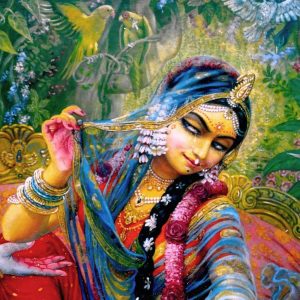 His praṇaya), how can Kṛṣṇa exist? He is zero without Rādhā.
His praṇaya), how can Kṛṣṇa exist? He is zero without Rādhā.
But the verse states rādhā-kṛṣṇa-praṇaya-vikṛtir, so how has She manifested? This is the question. It may be said that at first there was no Rādhikā, and then She manifested as the transformation of Kṛṣṇa’s praṇaya, His hlādinī-śakti. How has She come to be Rādhikā?
The answer is that Rādhā and Kṛṣṇa cannot be separated under any circumstance. She was present with Kṛṣṇa internally, and then She manifested externally as the transformation of kṛṣṇa-prema (kṛṣṇa-prema-vikāra). Hlādinī-śakti is never separated from Kṛṣṇa. When They are together as two, They are Rādhā and Kṛṣṇa, and when They again become one, They are Śrī Caitanya Mahāprabhu. In this way, Caitanya Mahāprabhu is not different from Śrī Śrī Rādhā-Kṛṣṇa.
Who manifested first, Śrī Caitanya Mahāprabhu or Rādhā and Kṛṣṇa? When we ‘count from’ Mahāprabhu, then Mahāprabhu is first, and when we ‘count from’ Śrī Śrī Rādhā-Kṛṣṇa, then Rādhā-Kṛṣṇa come first and after that, Mahāprabhu.
Śrīpāda Mādhava Mahārāja: Both are eternal.
Śrīla Bhaktivedānta Nārāyaṇa Mahārāja: When Kṛṣṇa is together with Rādhā He is rasa-vigraha, the embodiment of rasa, or transcendental mellows. He is viṣaya, the enjoyer of rasa, the object of love.
When He is enriched with rādhā-bhāva, then He is Mahāprabhu, the āśraya-vigraha, the embodiment of love for Kṛṣṇa. When He is Mahāprabhu He is rasarāja-mahābhāva, the combination of Rādhā and Kṛṣṇa, and He is the āśraya, or abode, of prema.
Walking with A Saint – Morning Walks and Conversations January 25, 2009 Morning Walk
Śrīla Bhaktivedānta Nārāyaṇa Mahārāja: Are there any questions?
Śrīpāda Bhāgavata Mahārāja: Yes, I have a question. I’ve been thinking about this question.
The nitya-siddha gopīs are expansions of Śrīmatī Rādhikā, or svarūpa-śakti. Are the mañjarīs also expansions of Śrīmatī Rādhikā? Are they also expansions of svarūpa-śakti?
Śrīla Bhaktivedānta Nārāyaṇa Mahārāja: Not all.
Śrīpāda Bhāgavata Mahārāja: Regarding the ācāryas who come in our sampradāya from Mahāprabhu, are they svarūpa-śakti expansions of Śrīmatī Rādhikā?
Śrīla Bhaktivedānta Nārāyaṇa Mahārāja: Who?
Śrīpāda Bhāgavata Mahārāja: All those who have come in our paramparā, like Śrīla Narottama dāsa Ṭhākura and all others.
Śrīla Bhaktivedānta Nārāyaṇa Mahārāja: The associates of Rādhā-Kṛṣṇa such as Rūpa Mañjarī, and the associates of Mahāprabhu such as Rūpa Gosvāmī…
Śrīpāda Bhāgavata Mahārāja: Are they all direct expansions?
Śrīla Bhaktivedānta Nārāyaṇa Mahārāja: In Kṛṣṇa’s pastimes they are associates of Śrīmatī Rādhikā; Her expansions. In Śrī Caitanya Mahāprabhu’s līlā they are expansions of Nityānanda.
Walking with A Saint – Morning Walks and Conversations May 28, 2009 Morning Walk
Śrīpāda Dāmodara Mahārāja: Is it true that among all incarnations, only Advaita Ācārya manifested old age?
Śrīla Bhaktivedānta Nārāyaṇa Mahārāja: What about Nityānanda Prabhu and Mahāprabhu?
Śrīpāda Dāmodara Mahārāja: They did not become old.
Śrīla Bhaktivedānta Nārāyaṇa Mahārāja: What do you consider the age of forty-eight to be? It is not kiśora (teenage).
Rāmacandra dāsa (from Delhi): He was forty-eight years old, but did He look like forty-eight?
Śrīla Bhaktivedānta Nārāyaṇa Mahārāja: Only Kṛṣṇa is always kiśora – nava-kiśora-naṭavara (the ever-fresh and youthful teenage dancer). That is the nature of His transcendental body.
Śrīpāda Mādhava Mahārāja: When Kṛṣṇa was in Kurukṣetra during the solar-eclipse, still He appeared as a teenager. So, Mahāprabhu must be the same.
Śrīpāda Dāmodara Mahārāja: When Lord Rāmacandra appeared, He also always had the form of a sixteen-year-old.
Śrīla Bhaktivedānta Nārāyaṇa Mahārāja: When His age was 11,000 years old, He looked like a full youth – not old, but not kiśora.
Vrajanātha dāsa: Dāmodara Mahārāja is saying that Advaita Ācārya looks like an old man. So, what about other incarnations, like Vyāsa?
Śrīla Bhaktivedānta Nārāyaṇa Mahārāja: Vyāsa had the appearance of an old man. He had a long beard.
Walking with A Saint – Morning Walks and Conversations August 10, 2009 Morning Walk
Śrīpāda Dāmodara Mahārāja: In Śrī Caitanya Mahāprabhu’s līlā, some devotees worship Him in an aiśvarya mood and some in a mādhurya mood.
Śrīla Bhaktivedānta Nārāyaṇa Mahārāja: Those who consider Mahāprabhu’s navadvīpa-līlā to be full of aiśvarya do not know the true nature of that dhāma. Such persons have not heard hari-kathā from the lotus mouth of a sādhu.
For the sādhaka, however, Śrīla Bhaktivinoda Ṭhākura has written that the devotee first worships Gaurāṅga Mahāprabhu in dāsya-rasa. Then, when his devotion matures, his bhakti is naturally transferred to Śrī Śrī Rādhā and Kṛṣṇa.
Śrīpāda Dāmodara Mahārāja: Jaiva-dharma states that Sannyāsī Ṭhākura had a vision of Māyāpura, at which time he saw Brahmā with four-heads. This is aiśvarya.
Vrajanātha dāsa: He also saw so many palaces.
Śrīla Bhaktivedānta Nārāyaṇa Mahārāja: It may be so, but Mahāprabhu’s pastimes in Navadvīpa are mādhurya-maya, full of the sweet mood of naravata-līlā (humanlike pastimes).
Although Mahāprabhu showed so many aiśvarya forms in Murāri Gupta’s house, and also in Śrīvāsa Ācārya’s house, that was not His natural mood.
Draupadī called to Kṛṣṇa to save her, but this was not her natural mood; it was a special mood. Similarly, Śrī Caitanya Mahāprabhu exhibited aiśvarya-līlā in certain special cases, in order to show Śrīvāsa Paṇḍita, “I am Vaikuṇṭha-deva, the Lord of Vaikuṇṭha,” and to show others, “I am Rāma.”
Śrīpāda Dāmodara Mahārāja: Is Śrīvāsa Paṇḍita a mādhurya-bhakta?
Śrīla Bhaktivedānta Nārāyaṇa Mahārāja: He is said to be Śrī Nārada Ṛṣi. Nārada has both aiśvarya and mādhurya moods.
Śrīpāda Niṣkiñcana Mahārāja: Gurudeva, how does an aspiring devotee worship Mahāprabhu in a mood of dāsya, servant?
Śrīla Bhaktivedānta Nārāyaṇa Mahārāja: That devotee considers, “I am His servant.” In kṛṣṇa-līlā Raktaka and Patraka are in this mood, and in rāma-līlā it is the mood of Hanumān. Similarly, the aspiring devotee of Mahāprabhu thinks, “I am an eternal servant of Mahāprabhu.”
jīvera ‘svarūpa’ haya—kṛṣṇera ‘nitya-dāsa’
kṛṣṇera ‘taṭasthā-śakti’ ’bhedābheda-prakāśa
(Śrī Caitanya-caritāmṛta, Madhya-līlā 20.108)
[It is the living entity’s constitutional position to be an eternal servant of Kṛṣṇa because he is the marginal energy of Kṛṣṇa and a manifestation simultaneously one with and different from the Lord.]
Śrīpāda Dāmodara Mahārāja: Śrīla Rūpa Gosvāmī and Śrīla Sanātana Gosvāmī are in the mood of sakhya (friends) towards Mahāprabhu?
Śrīla Bhaktivedānta Nārāyaṇa Mahārāja: No. They have dāsya-bhāva towards Mahāprabhu, and with Kṛṣṇa they are in mañjarī-bhāva.
Śrīpāda Dāmodara Mahārāja: Mother Śacī is also in dāsya-bhāva?
Śrīla Bhaktivedānta Nārāyaṇa Mahārāja: Yes.
Śrīpāda Dāmodara Mahārāja: So how is this mādhurya-maya (full with the sweet mood of human-like relations)?
Śrīla Bhaktivedānta Nārāyaṇa Mahārāja: She has dāsya-bhāva, but in vātsalya-rasa.
Śrīpāda Mādhava Mahārāja: Vātsalya-rasa is prominent.
Śrīla Bhaktivedānta Nārāyaṇa Mahārāja: The gopīs are servants of Kṛṣṇa in mādhurya-rasa, and Baladeva Prabhu is also a servant. However, in the ‘eyes’ of rasa, this is seen as vātsalya, sakhya, and mādhurya.
Walking with A Saint – Morning Walks and Conversations August 11, 2010 Afternoon Darśana
Śrīla Bhaktivedānta Nārāyaṇa Mahārāja: There is only one way. By that method we can practice bhakti-yoga. Śyāmarāṇī has a question?
Śyāmarāṇī dāsī: Yes, Gurudeva, I do. I was just now giving class, and one of the devotees quoted you as saying that Gaura-Nitāī Deities can be worshipped in the mood of Rādhā and Kṛṣṇa, because Mahāprabhu is Rādhā and Kṛṣṇa combined.
Śrīpāda Mādhava Mahārāja: Gurudeva never told this.
Śrīla Bhaktivedānta Nārāyaṇa Mahārāja: It is true that He [Śrīman Mahāprabhu] is Rādhā and Kṛṣṇa combined. He taught this by His own life’s example. But, it is only after worshipping Him for some time as Gaura that His worship will turn into Kṛṣṇa worship.
First serve in dāsya-bhāva [perform worship in the mood of an obedient servant] to Śrī Caitanya Mahāprabhu. Then, after some time, when that worship will be completed, it will be transferred into kṛṣṇa-bhakti.
Śyāmarāṇī dāsī: So, when the devotees are offering bhoga (foodstuffs) to the Gaura-Nitāī Deities, they should not utter śrīṁ klīṁ rādhā-kṛṣṇābhyāṁ svāhā? How will they offer their bhoga?
Śrīla Bhaktivedānta Nārāyaṇa Mahārāja: Idaṁ naivedyaṁ klīm gaurāya svāhā. Mahāprabhu is Kṛṣṇa, so we utter the word klīṁ as His seed mantra [ka stands for ‘Kṛṣṇa,’ la stands for ‘Rādhā,’ and īṁ stands for ‘the living entity in Their service’]. But Nityānanda Prabhu is not Kṛṣṇa, so for Him we utter oṁ nityānandāya svāhā. Your whole body is made of questions.
Śyāmarāṇī dāsī: Fortunately your whole body is made of answers, so I am lucky.
Walking with A Saint – Morning Walks and Conversations June 13, 2010 Morning Walk
Śrīpāda Dāmodara Mahārāja: In gaurāṅga-līlā, do the devotees remember Rādhā-Kṛṣṇa or Mahāprabhu?
Śrīla Bhaktivedānta Nārāyaṇa Mahārāja: Rādhā-Kṛṣṇa. Mahāprabhu did not think of Himself as God, Kṛṣṇa. Only a few knew.
Śrīpāda Mādhava Mahārāja: Once, when Mahāprabhu was in Navadvīpa, He went with Jagadānanda Paṇḍita to the bank of the Ganges, and there He caught a parrot and told it to chant, “Kṛṣṇa, Kṛṣṇa.” But instead it was chanting, “Gaura Gaura.” When Mahāprabhu said, “Don’t chant, ‘Gaura Gaura,’ ” it replied, “I am living in this place, so I prefer to chant ‘Gaura, Gaura.’ ” Jagadānanda Paṇḍita wrote this in his Prema-vivarta.
Walking with A Saint – Morning Walks and Conversations May 24, 2010 Darśana
Raghunātha dāsa: Śrīla Gurudeva, you have said several times that while chanting japa, one has to meditate on Kṛṣṇa. Should we meditate also on mahāprabhu-līlā? Can we meditate on both mahāprabhu-līlā and kṛṣṇa-līlā? Or should we meditate only on rādhā-kṛṣṇa-līlā while chanting japa?
Śrīla Bhaktivedānta Nārāyaṇa Mahārāja: It is better to do what Caitanya Mahāprabhu ordered us to do. Mahāprabhu told us to chant “Hare Kṛṣṇa,” so we do this. This practice is sādhana-bhakti – to achieve bhāva-bhakti and then prema-bhakti.
Image/Art made possible by Pixabay.com & Krishnapath.org


